The Air Force Half Marathon was a huge success!
Fair warning, this will be my most extensive race recap yet. There is a lot to cover between my goals going into this race, my training and preparation, the MAJCOM Challenge, and how the actual race itself went.
Pre-Race Goals
The previous personal record for the half marathon distance was 2:08:11, which I set at the Salt Lake City Half Marathon in April 2019.
For the Air Force Half Marathon, I REALLY wanted to run a 2-hour half marathon. I knew this would be another huge PR so I set my mind to it, dedicated myself to my training plan and nutrition to make it happen.
Training Plan and Preparation
For this race, I used the Hal Higdon Advanced Half Marathon plan.
This plan was difficult with two speed workouts during the week and higher mileage than I was used to. It called for a track or hill workout on Mondays, easy run Tuesdays, tempo run Wednesdays, rest on Thursdays, easy run Fridays, long run on Saturdays, and easy run on Sundays. I also incorporated leg strength after my Monday track workout and upper body strength before my Sunday easy run.
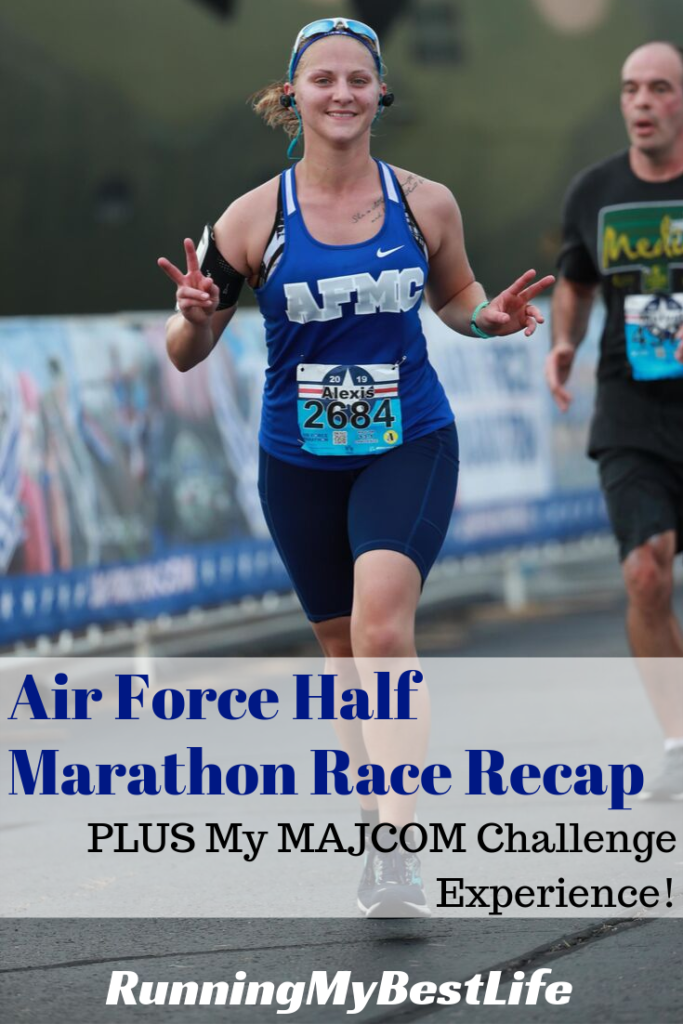
I’ll be honest, I didn’t follow this plan perfectly.
After the first few weeks, I found out that my legs were still too sore for a tempo run on Wednesday after I did my leg strength on Monday, so I moved my rest day to Wednesday and my tempo run to Thursday. Also, there were several Sundays where we were either too busy to get a workout in, or I was too sore and decided I needed the extra rest day. You’ll see in this plan that I used Sunday as my second rest day several times.
I also was really sick with a head cold the last week in August, so I took a couple extra days off that week. Despite taking a few days off that week, I actually ran a new personal record 5k on Saturday when I was still recovering from my cold. It’s like all that extra rest was a forced taper for the 5k! There were several local 5k’s in my area during this training plan, and I wasn’t able to find any 10k’s or 15k’s close by on the dates that I needed them, so I wasn’t able to race anything longer than a 5k in preparation for the Air Force Half Marathon.

The MAJCOM Challenge
The MAJCOM Challenge is its own special competition within the Air Force Marathon. The challenge is comprised of 12 teams, each representing their own Major Command. Each team is made up of 10 members: 4 that run the full marathon (3 males, 1 female) and 6 that run the half marathon (4 male, 2 female).
At the end of the race, each person’s time is compiled for the team’s total time, and the fastest time wins the MAJCOM Challenge and is presented with a trophy that gets displayed in the MAJCOM’s home office until the next competition.
If a team doesn’t fill all of their slots, they get assigned a “ghost runner,” with an extremely slow corresponding time. This effectively acts as a handicap, so teams are encouraged to have an actual runner in every single spot on their team.
Any Air Force personnel can apply to be part of their MAJCOM team, and the fastest times submitted are typically chosen to be on the team. Applications are typically due around May 1st each year, and the team members are typically announced in June.
Interested Air Force members can find more information, updates about the MAJCOM Challenge, and directions to apply on the Air Force Marathon official website.
My MAJCOM Challenge Experience
My expectations were far exceeded and the MAJCOM Challenge will definitely stand as one of my fondest Air Force memories. The MAJCOM Challenge made this weekend and the Air Force Half Marathon more than just a race. It was an incredible experience.
I almost didn’t apply, because my fastest half marathon time on the application was 2:08:11, and many of the previous female half marathon times were closer to 1:40-1:50. However, when I looked at the previous years’ MAJCOM Challenge results, there were several females who ran the half marathon slower than my personal best, so I gave it a shot and applied.
As it turns out, my MAJCOM did need a female half marathoner, and I made the team!
We actually didn’t have any females apply in the first round of applications for the full marathon, so they opened applications again for a short window and I was able to reach out to a Facebook group I’m in to find an active duty female willing to run the full marathon in our MAJCOM. We ended up filling all 10 slots on our team.
A Sponsored VIP Experience
The MAJCOM Challenge was funded via Air Force Sports. My travel, hotel, and race registration were all paid for. I honestly felt like a sponsored runner the entire weekend!
The day before the race, we were invited to meet our 4-star General MAJCOM Commander in his office. That night, we had reserved tables at the Pasta Dinner, which we also received free tickets for.
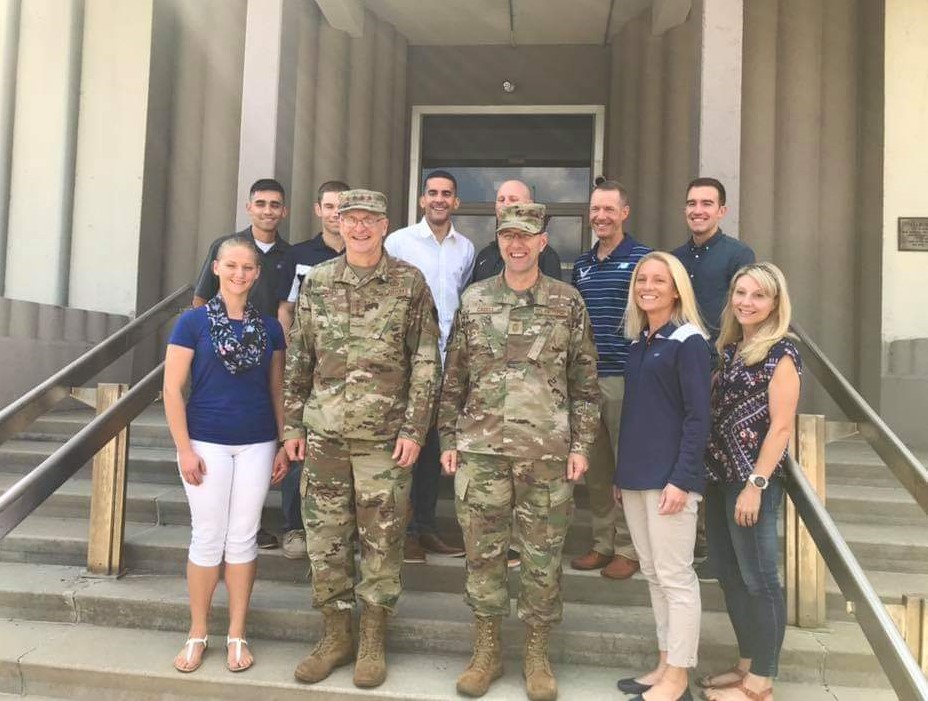
On race morning, they provided a special shuttle bus for MAJCOM runners from the front door of our hotel right to the race. We got to bypass all the traffic, public shuttles, trying to park over a mile away from the starting area, and the security lines.
They provided a tent for us with as much water and Gatorade as our hearts desired. The tent also had tables and chairs and was guarded by security so we could leave our bags in the tent rather than having to check them at the gear check. About 30 minutes before the race started, it POURED rain and I was super thankful to be in an area where I could stay dry!
Our tent was right next to the distinguished visitor tent, so chatting with high-ranking officers became completely normal throughout the weekend.
We even got our own porta potties right behind our tent, which were blocked off from the general public! And the best amenity was the massage tent reserved for the MAJCOM runners and distinguished visitors, so I was able to get a massage shortly after the race without having to wait in the huge line at the massage tent available to the general public.
Sandwiches, chips, and bagels were also provided for lunch right in our tent. Seriously, they treated us like royalty!
The one part that made this experience incredible though, was the people.
Air Force members are incredible people. Runners are also incredible people. When you combine the two and have a group full of runners who are also active duty Air Force, you get a team of amazing people who are positive and want everyone to succeed. Even though we were competing against everyone in the tent, we got to know each other before and after the race. We were all cheering each other on. Everyone was willing to help one another.
By the time I flew home on Sunday, I had friends everywhere I walked in the airport terminal. It was truly an awesome experience.
My Must-Have Gear for the Air Force Half Marathon
Obligatory “flat runner” photo!

This is my must-have gear for the race:
- Bib Number! (And safety pins)
- Comfortable Running Shorts (These ones have pockets!)
- Tank Top (This one was provided to me for being part of the MAJCOM Challenge)
- PRO Compression Socks
- Brooks Adrenalin 19 Running Shoes
- Reliable, Comfortable Sports Bra
- Body Glide
- Gels (I brought a Honey Stinger with me to take right before the race and relied on race-provided gels for the rest of the race.)
- Bose Soundsport Headphones
- Custom Oakley Half Jacket Sunglasses
- Phone Armband
Race Morning Routine
On race morning, the MAJCOM shuttle picked us up right at our hotel and dropped us off near the Air Force Half Marathon starting line. This was really convenient as we saw the ridiculous amount of traffic at the Nutter Center of runners trying to catch shuttles there.
When we got to the race, we were guided to our tent which had tables, chairs, water, Gatorade, and LIGHTS! We arrived around 5AM, so it was pretty dark still and we had quite a bit of time to kill waiting for the race start to get closer.
My team took a photo around 0630, after our final team member arrived. After the photo, everyone started going through their warm-up rituals.

Inside the Air Force Half Marathon: Recapping the Miles
Ok, now it’s time to talk about the actual race!
About 30 minutes before the race, it started POURING rain. At that point, I was super thankful to be under a tent and staying dry. However, it was still drizzling when I walked out 20 minutes later to head to the starting corrals. Thus, I was still wet before the race even began.

My husband planned to run with me for the first few miles of the race, so we found the 2-hour half marathon pacer and lined up. There was some thunder and distant lightning, but no one was really concerned about it. The emcee announced that we would be starting in “just a few minutes.”
10 minutes later…we were all still waiting to start the race. They announced that there was lightning on the course, which was the primary reason for the delay. Instead of starting at 0730 as scheduled, they planned to start the opening ceremonies at 0800. The temperature at the start was just over 70 degrees, and the air was humid. Everyone was really looking forward to the effect that would have on their race…NOT.
By that point, I had to pee. I probably would have sweated it out if we started running on time, but once it was in my bladder, it was there to stay.
Around 0810, we finally started running!
Start Through Mile 5
After the race was finally underway, the start seemed to go fairly smooth. I spent the first few miles checking our pace on my Garmin Forerunner 35 to make sure we weren’t going out too fast. We were aiming to keep our pace between 8:45 min/mile and 9:05 min/mile.
My full bladder bothered me a little bit, and at the 3 mile aid station, I ran off the course to see if any of the porta potties were empty. They were all occupied, and I didn’t want to waste time waiting in line, so I kept running. Around mile 4, my husband decided it was time for him to pick up the pace, so he went on his way.
At the mile 5 aid station, I was able to find an empty porta potty and make a quick stop to relieve my bladder. Amazingly, I only lost 30 seconds. At that point, however, I also lost the 2-hour pace group. I tried to speed up my pace a bit to see if I could catch the group again, but there was also a hill right after the mile 5 mark, so this proved to be not so easy.
My Fueling Strategy Derailed
Also, I realized that the gels that were promised at the mile 5 aid station were not provided. At this point, I panicked a bit. I chose not to carry my own gels on this race (although I did take one right before the start) because of the fact that I was in the MAJCOM uniform, and didn’t want to carry my trusty running belt that I usually take with me. There were some nasty hills during this race and I would no doubt need all the fuel I could get to avoid hitting the wall.
At the next aid station, I realized that the gels probably wouldn’t show up randomly somewhere. I kept my eyes peeled for any carb source and racked my brain for ideas on where to take my fueling strategy from here so I could avoid hitting the wall as long as possible.
Finally, I decided that taking 2 cups of Gatorade at each aid station was my best bet. That way, I could get twice as many carbs from Gatorade and although it wasn’t my ideal situation, maybe it could prevent disaster and help me finish with a respectable time.
Mile 5 Through Mile 9
When I tried picking up my pace to catch the 2-hour pace group, my knee started to twinge a bit. I decided that was a terrible idea, so I kept my pace moderate and focused on pushing forward and ticking off the miles with good form. Every time I let my form go, my knee started to hurt again.
It seemed like everything was going wrong. I lost time to hit the porta potty and pee. There weren’t any gels at mile 5 and I would surely hit the wall before I reached the finish line. My knee started acting up.
I wondered if it was even worth it to keep pushing. Around mile 6 or 7, I knew that the 2-hour mark was unrealistic for this race. Too many things were going wrong. Murphy’s law was in full effect.
Wearing the MAJCOM jersey, I felt like giving up was NOT an option. I couldn’t quit, because I was representing more than myself in this race. Plus, my team was relying on me to put up a solid time and help our aggregate time. I told them I planned to finish in 2 hours, so I needed to stay as close to that mark as the conditions would allow.
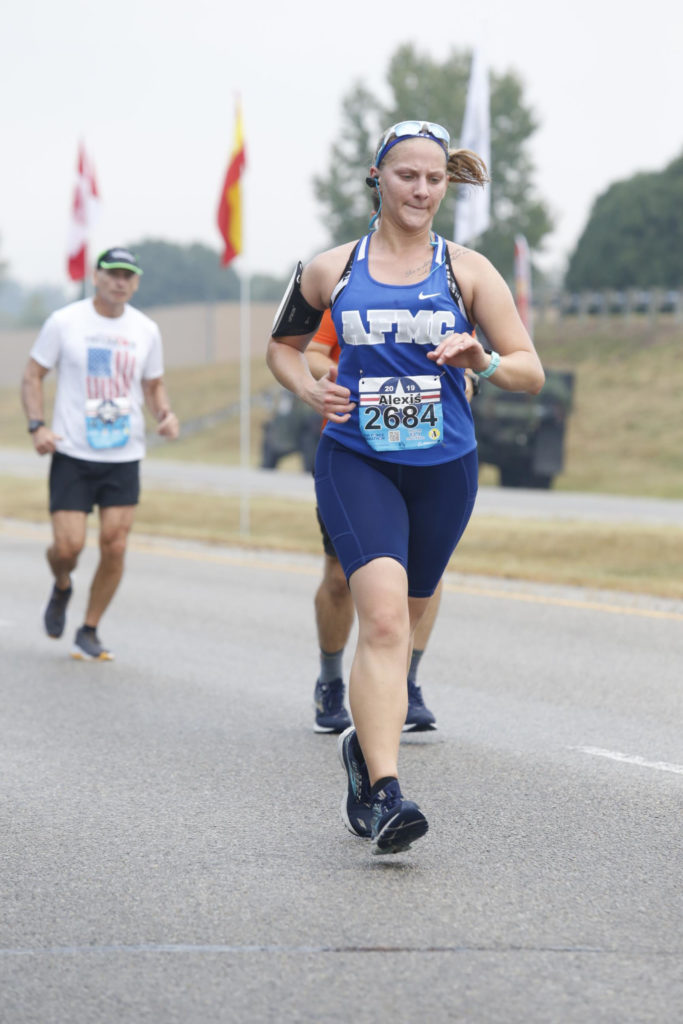
Looking back, I don’t think I would have kept pushing if I didn’t have a team relying on me. If I had only been running for myself, I probably would have given up on any kind of time goal.
Around mile 8, the bulk of the hills for the race started. I kept taking 2 cups of Gatorade at each aid station and resorted to power-walking up the steepest parts of the hills to conserve energy.
Mile 9 Through the Finish
Gels were also supposed to be provided at mile 10, which I was fully expecting to not be there after being disappointed at mile 5. By mile 9, my pace had already started to slow significantly. Instead of running a 9:15 pace, I was now closer to a 10 min/mile pace. I could feel the wall coming towards me.
Thankfully, I did spot the guy handing out gels at mile 10. I gladly took one and gulped it town, washing it back with Gatorade. This seemed to help push the wall out, but the damage had already been done. My muscles were nearly toast, and it was a little late to come back from that.
The elevation continued increasing until around mile 11.
From mile 11 on, there was a HUGE downhill. All of that elevation gained from miles 5 through 11 would be dropped in less than one mile. I was planning on making up some time and flying down this hill but…my legs were already shot. What I thought was a very quick pace turned out to be just slightly better than I ran the previous uphill miles. Its funny how your mind thinks you’re running fast at the end of a race, when really your legs are trudging through peanut butter…

Now, if you’ve ever run the Air Force Half Marathon, you know that the finish line is deceiving. After you pass the mile 12 marker, you can see the finish area. You can see all of the flags lined up, the aircraft that the finish line runs under, and the big finish arch. It seems so close, so you speed up (shall I say…attempt to speed up).
Then, you come to the corner, and realize that you still have a half mile to go when the course takes a sharp turn. Even though you’re close to the finish line, you still have to go around the long way to get there!
The area circled below is the spot of disappointment when you realize that you aren’t as close to the finish line as you thought you were.
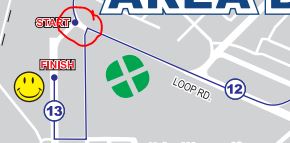
FINISH LINE!!
FINALLY, I crossed the finish line at 2:04:14. This was nearly a 4 minute personal record from my last PR of 2:08:11.

Despite projecting hard for a sub 2-hour race, I knew that this personal record was still an awesome performance considering the race conditions. The Air Force Half Marathon was a tough race. It was hot, humid, the start got delayed, I had to pee mid race, I didn’t get the gels I was relying on at a critical point in the race (and I didn’t think to carry any with me), my knee decided to twinge a few times during the race, and there was a crap ton of nasty hills.
I know my fitness is there, and the next time I get a shot at the half marathon distance, I’m going to crush the 2-hour mark.
You better bet I rang that PR bell with pride!

Post-Race Recovery
After the race, lunch was already catered to our tent. I changed into some dry clothes and downed my Generation UCAN Performance Energy + Protein recovery shake before getting into the real food. My muscles would thank me later.
For the rest of the day, I focused on hydrating with Nuun and resting.
After a shower and short nap, we hit up the Mexican restaurant across from our hotel for some delicious food and margaritas. Disclaimer: Alcohol really doesn’t support your recovery. But the margaritas tasted great!

Are You Ready to Run a Half Marathon?
My first half marathon completely changed my perspective on live and opened up a new door in my identity. After running consistently for over 2 years, this was the first time in my life I have ever been referred to as an athlete.
Fostering the identity of a runner has helped me stay healthy, increase my fitness, slim down, and break through new challenges. My first half marathon was really when I started to see myself as a runner.
If you’re ready to run your first half marathon, sign-up for the “12 Weeks to Your First Half Marathon” course.
In this course, I guide novice runners through all the elements needed to train and race your first half marathon, including:
- Selecting a Training Plan
- What to focus on when you first start training
- Which nutrition plans work the best while training
- What gear you NEED and what can wait
- The essential types of runs and how to train with them
- How often you should race shorter distances while training
- Staying motivated when the training gets tough
- Essential recovery tactics
- How to taper for a race
- What you need to prepare for and how to navigate race day
- Plus much more!
If you’re not ready for the full course yet, you can get started for FREE with my 6-Day intro course on how to get started training for your half marathon.
The kickstart course sets you up with everything you need to kick off your training including a workout tracker, training plan recommendations, and mindset training.
[convertkit form=964110]
What is your favorite part about running a half marathon?
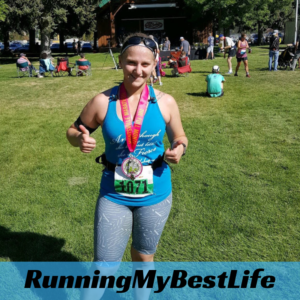
Run Happy,
Alexis
- Nailing Your Marathon Hydration Strategy: A Comprehensive Guide
- Conquering Marathons in the Cold: A Comprehensive Guide
- Harnessing the Power of Technology for Successful Marathon Training
- Mastering the Marathon: The Ultimate Guide to Nutrition and Training
- Ultimate Guide to the Top 5 Running Shoes for Beginners in 2023
About Me: I’m Alexis, Founder of RunningMyBestLife! I am an avid recreational runner, half marathoner, wife, dog mom, busy professional, downhill skier in Northern Utah. My mission is to help new enthusiasts fall in love with the sport of running. I believe that running is a catalyst to taking control of your life and living your best life by design. Learn More –>